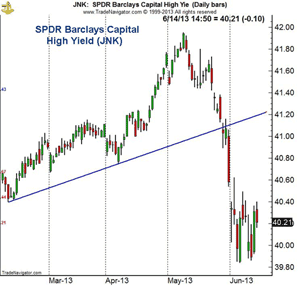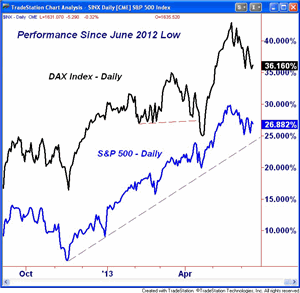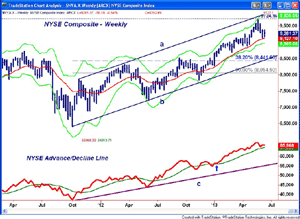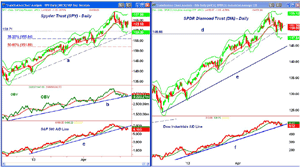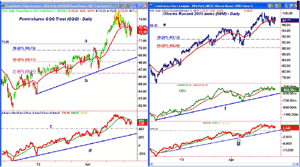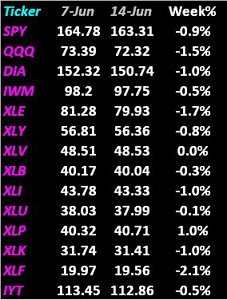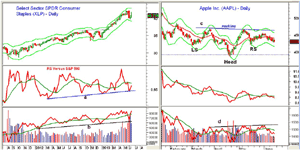The market has reached a level where next week could go either way. But something could happen next week to turn the momentum negative, and MoneyShow's Tom Aspray suggests being very careful with your potential risk if you plan on new buying in the short term.
Stocks had another choppy week, as stocks tried to continue higher early on, but then turned lower Tuesday afternoon.
After Wednesday's dismal performance, Thursday's strong close stabilized the market, even despite Friday's lower close. I was expecting the prior week's lows to be broken, but they were not.
The yields on both short- and longer-term bonds declined a bit, which gave bondholders a bit of relief after what has been a tough six weeks.
Many bondholders are in shock, especially those in the high-yield or junk market. The chart of the SPDR Barclays Capital High Yield (JNK) shows that it hit a high of $41.95 on May 8, followed by a low on June 6 of $39.84. This was a drop of just over 7%, making its yield of 6.64% look much less attractive.
This is worse than the decline in the S&P 500 from the recent high at 1,687 to the intraday low of 1,598, which was just over a 5% decline. Many stock investors were apparently buying on the last decline, but are still wondering whether they should have waited to buy lower.
So what will the rest of the year bring for bond- and stockholders? More pain or more gain?
The completion of the weekly reverse H&S bottom formation for 30-year T-Bond yields, as discussed in my Eyes on Income column, does favor higher yields as the year progresses. Many investors are also hoping to get some clarification of Fed policy this week after the FOMC meeting, but I think the Fed will want to keep the market guessing.
Even TIPS (Treasury Inflation-Protected Securities) have been hit hard. Lower inflation numbers and fears that the Fed would stop their bond buying has caused significant outflows, as the chart indicates. The returns have also dropped into negative territory after giving double-digit returns in 2011.
The bond market is oversold, so a rebound is likely over the next few weeks. As I mentioned a couple of weeks ago in 4 Ways to Summer-Proof Your Portfolio, I would use any rebound to lighten up on the bond portion of your portfolio, and also shorten the maturity of your holdings. I think there will be more pain for bondholders later in the year.
NEXT: What to Watch
|pagebreak|So what about the stock market? The sharp drop in the Japanese market has gotten most of the attention from global equity investors, but as I noted last week, some of the key Japan ETFs have reached or are very close to good buying levels.
The rest of the global markets simply appear to be going through normal corrections. The German Dax did briefly break more important support in April before again making new highs. It has continued to lead the S&P 500 since the June 2012 lows, up 36% versus a 26% gain in the S&P.
There are no clear signs yet that the stock market correction is over. Therefore, further weakness is still likely. However, fact that the weekly NYSE Advance/Decline line did confirm the recent highs keeps the major trend positive, and further new highs in the major averages should be expected later this year.
The economic calendar was light last week, but retail sales were quite strong, while industrial production and the mid-month reading from the University of Michigan on consumer sentiment were a bit lower. All are still in positive trends, and as I discussed in A Technical Look at Fundamentals, I find it quite informative to look at fundamental data using technical analysis.
On the other hand, get ready for a full slate of economic data this week, starting Monday with the Empire State Manufacturing Survey and Housing Market Index. The latter helped confirm the bottom in the housing market a year ago, when many were still skeptical.
Then, on Tuesday the FOMC begins their meeting, and we also get the Consumer Price Index and housing starts. On Wednesday afternoon, the conclusion of the FOMC meeting comes out, as well as the press conference with Ben Bernanke, which does occasionally increase market volatility.
Of course, jobless claims are out Thursday, along with the PMI Flash Manufacturing Index, existing home sales, and the Philadelphia Fed Survey.
What to Watch
During last week, the stock market was able to please both the bulls and the bears. However, neither were all that happy by the week's close.
Last week, I was expecting the rebound in the S&P 500 to "fail in the 1,650 to 1,660 area." The S&P 500 peaked at 1648.62 on Monday, and then by mid-day Tuesday it was clear that the rally had failed.
For those who follow me on Twitter, long positions in the ProShares Ultrashort S&P 500 ETF (SDS) were established at $39.55. The first target is now in the $42.50 area, followed by $45.
With the rebound from Thursday's lows, one has to consider that the correction may be near its end, though it is not currently indicated by the technical studies. If we see two consecutive days of solid price gains along with strong A/D numbers, it could shift the outlook.
Sentiment did not change much last week, and I still think we need to see a break of the 1,585 support on the S&P 500 to create enough negative sentiment for the market to bottom out. Individual investors became a bit more bullish last week, up to 33% from 29.5% the prior week. However, financial newsletter writers fell to 43.8% bullish, down from 45.8%, and the bears picked up a few percentage points.
The number of NYSE stocks above their 50-day MAs, which I explained in a recent Trading Lesson, rose to 54 last week after hitting a low of 45. This was not as oversold as the readings at the April lows.
The weekly chart of the NYSE Composite shows that it held above the 20-week EMA at 9,124, as well as the prior week's low. The correction has taken prices below the April high, and the weekly Starc- band now sits at 8,960.
The minor 38.2% Fibonacci retracement support from the June 2012 lows is at 8,757, and the major 38.2% support waits at 8,441.60. This is calculated from the October 2011 low.
The weekly NYSE Advance/Decline line did confirm the highs four weeks ago. It is still slightly above its WMA, and also well above long-term support (line c). If the weekly A/D line starts a new downtrend, it will signal a deeper correction.
As I reviewed last week, the daily uptrend was broken last week, and its WMA is still clearly declining. This is also consistent with a further correction.
NEXT: Stocks
|pagebreak|S&P 500
The daily chart of the Spyder Trust (SPY) shows slightly higher lows over the past two weeks. The next widely watched level of support is at $159.71 and the April highs. The daily uptrend and the Starc- band are now in the $159 to $159.27 area.
The minor 38.2% Fibonacci retracement support sits at $155.94, with the 50% support at $151.89. The daily on-balance volume (OBV) is holding its uptrend (line b), but is now below its WMA. The weekly OBV (not shown) is still above its WMA, however.
The daily S&P 500 A/D line violated its uptrend (line c) on June 5, and just rebounded back to it and the declining WMA last week. A day of very negative A/D numbers early in the week will turn it more negative.
First resistance waits in the $164.50 to $165.40 area. A convincing close above $165.40 would be the first sign that the correction is over.
Dow Industrials
The SPDR Diamond Trust (DIA) closed the week lower, but above $148.31, which was the prior week's low. It is now the support level to watch. The April highs of $148.66 were violated earlier in the month.
The daily Starc- band is at $147.51, and monthly pivot support can be found at $146.74. The uptrend (line e) at $144.50 should provide more important support.
The daily Dow Industrials A/D line closed the week just above its uptrend (line f). The A/D line does show a pattern of lower highs and lower lows, which is a sign of weakness. Resistance for DIA currently stands at $152.35 to $153.
Nasdaq-100
The PowerShares QQQ Trust (QQQ) held just above the prior week's low at $71.47, with the September high (line a) at $70.58. The 38.2% support level at $69.72 should hold on a further correction.
The Nasdaq-100 A/D line tested its declining WMA last week, and shows a slight pattern of lower highs and lower lows. The A/D line has next support at line c. There is next resistance at $73.76, with further levels at $74.21.
Russell 2000
The iShares Russell 2000 Index (IWM) stayed in a pretty tight range last week, with a high of $98.80 and a low of $96.37. The March high of $95.10 (line e) represents more important support. The 38.2% Fibonacci retracement support sits at $91.21.
The daily OBV is slightly below its WMA, but well above its strong support at the uptrend (line f). The daily A/D line has stayed in a narrow range recently, and closed the week below its WMA but well above support (line g).
Current resistance is around $99.20 to $100.38.
NEXT: Sector Focus, Commodities, and Tom's Outlook
|pagebreak|Sector Focus
The iShares Dow Jones Transportation (IYT) traded in a fairly tight range last week, and closed a bit lower. Volume was lighter last week than it was on the prior week's positive close. There is converging support now in the $107.50 area.
The weekly performance table below shows mostly minus signs, with the Select Sector SPDR Financial (XLF) the weakest at 2% lower, followed by the 1.7% drop in the Select Sector SPDR Energy (XLE).
The best performer was the Select Sector SPDR Consumer Staples (XLP),which was up 1%. The Select Sector SPDR Utilities (XLU) and Select Sector SPDR Health Care (XLV) were flat for the week.
The weekly chart of the Select Sector SPDR Consumer Staples (XLP) shows the higher close, as it held well above the prior week's lows. The recent high is at $42.20, and the weekly Starc+ band is now at $42.93.
XLP's relative performance has turned up, but is still below its flat WMA. The OBV has risen sharply over the past two weeks, and has moved well above its WMA.
In terms of the four index tracking ETFs, the iShares Russell 2000 Index (IWM) was down the least, losing just 0.5%.
The Select Sector SPDR Technology (XLK) was down just about 1%. One of its largest components is Apple (AAPL), which fell more than $11 for the week. Clearly, the World Wide Developers Conference did not give the stock much of a boost.
The daily chart of AAPL shows a potential reverse H&S bottom formation. A strong close above the $466 level would complete the formation. A drop below the potential RS at $418.90 would invalidate the formation.
Crude Oil
Crude oil closed the week strong again last week, above the highs of the past five weeks. The OBV has moved back above its WMA, which is a positive sign. This could be a positive indicator for the economy, and eventually support the overall market.
Precious Metals
The gold futures traded in a tighter range last week, but did close the week higher. The Spyder Gold Trust (GLD) was up only a bit, and needs a strong close back above the four-week highs at $137.62 to improve the momentum outlook.
The Week Ahead
By Tuesday afternoon, the market looked ready for another wave of selling, but it held up pretty well despite Friday's lower close. The technical formations still favor a deeper decline, and it's possible that disappointment over the FOMC meeting will trigger heavier selling.
As I said last week, sentiment still does not seem negative enough to set the stage for another major rally. An influx of new money from bondholders, who are seeing their principal dissipate, could support the stock market.
For the Income Portfolio, a partial position was established in the Select Sector SPDR Utilities (XLU) last week. A partial position was also established in the WisdomTree Japan Total Dividend Index (DXJ) last week.
We are watching a few other high-yield stocks that are getting closer to major support where they will look attractive for new investment. But concentrating on risk and entry for all new positions, as I have stressed from the beginning of the year, is even more important now.
The bottom line is that I expect more pain for bondholders by year-end, and more gains for patient (repeat: patient) stock investors.
- Don't forget to read Tom's latest Trading Lesson, A Technical Look at Fundamentals

